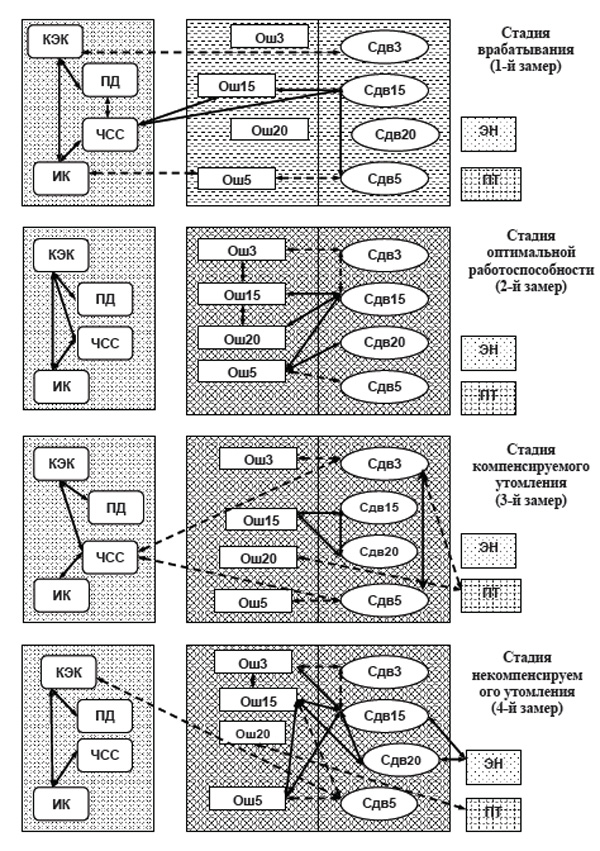Article
Shirokaya M.Yu. (2019). Perception of time intervals for different functional states of a working person. Moscow University Psychology Bulletin, 1, 141-157
Abstract
Relevance.The widespread introduction of digitalization and automation and their use in camera work leads to the acceleration of not only the labor process, but also the entire life of the labor subject. The effect of time perception on work was studied. However, the role of the subjective reflection of time intervals in an integrated system of labor activity in the conditions of work with time limits and deficits has not been studied enough.
Objective. Identification of the role and place of subjective assessment of professionally important time intervals in the system of regulation of activity in solving labor problems at different stages of the dynamics of the operator's performance in the production process.
Methods and sampling. Occupational study of labor; procedure for measuring time intervals; complex express methods for diagnosing the functional state of the subject of labor: 1) labor productivity, 2) physiological indicators, 3) subjective assessment of emotional tension (Spielberger — Hanin scale situational anxiety). The study involved female operators of the precision manufacturing “Assembly of Chips” of the electronics industry (21 people).
Results. The structure of the subjective assessment of the perception of professionally important time intervals determines the dynamic processes of time regulation. The temporal regulation of the labor of operators has specificity in different functional states arising at different stages of working capacity.
Conclusion. The time regulation of the main labor operations is central to the functional system of performing activities.
Sections: To the 70th anniversary of Anna Borisovna Leonova;
Received: 12/17/2018Accepted: 12/24/2018
Pages: 141-157
DOI: 10.11621/vsp.2019.01.141
Keywords: functional state; functional activity support system; time regulation of activity; subjective assessment of time intervals; performance dynamics;
Available Online 15.03.2019

Pic.1.
Table 1.
|
Компоненты СОВИ |
Компонент трудовой деятельности |
Расчет/условное обозначение
|
|
Когнитивный — абсолютная величина отклонения СОВИ от заданной |
Микрооперации (3с и 5с) |
Средняя ошибка СО 3с за одну экспериментальную серию (замер)/ош3 Средняя ошибка СО 5с за один замер/ош5 |
|
Основная операция (15с) |
Средняя ошибка СО 15с за один замер/ош15 |
|
|
Технологический цикл (20с) |
Средняя ошибка СО 20с за один замер/ош20 |
|
|
Рефлексивный — относительная величина отклонения СОВИ (сдвиг) в сторону переотмеривания (‒) или недоотмеривания (+) |
Микрооперации (3с и 5с) |
Направление сдвига СО 3с/сдв3 Направление сдвига СО 5с/сдв5 |
|
Основная операция (15с) |
Направление сдвига СО 15с /сдв15 |
|
|
Технологический цикл (20с) |
Направление сдвига СО 20с /сдв20 |
Table 2.
|
№№ |
Измерение/ Методики |
Показатели |
Формула расчета |
Усл. обозн. |
|
Производительность труда |
||||
|
1 |
Хронометраж |
Производительность труда |
[Время распайки выводов] : [кол-во выводов 1 платы]
|
ПТ |
|
Физиологическое состояние |
||||
|
2 |
Пульс |
Частота сердечных сокращений |
[Кол-во ударов за 30 с]×2 |
ЧСС |
|
3 |
Артериальное давление |
Артериальное давление [систолическое и диастолическое давление] |
Абсолютные значения АД |
АДc АДд |
|
Физиологические показатели, производные от ЧСС и артериального давления |
||||
|
4 |
|
Пульсовое давление (уровень энергетической мобилизации) |
[Адс–АДд] |
ПД |
|
5 |
|
Индекс Кердо (баланс симпатической и парасимпатической активации) |
[1–АДд : ЧСС]×100
|
ИК |
|
6 |
|
Коэффициент эффективности кровообращения (уровень энергетической мобилизации) |
[ЧСС×ПД]/100
|
КЭК |
|
Эмоциональное состояние |
||||
|
7 |
Шкала ситуативной (реактивной) тревожности Спилбергера—Ханина |
Субъективная оценка эмоциональной напряженности |
[S «прямых» ответов – S «обратных»] + 50 |
ЭН |
Table 3.
|
Замеры |
Показатели СОВИ, ФС, ПТ |
|
1 — 2 |
Сдв20 (‒1.9*) |
|
1 — 3 |
ЧСС (‒2.19*), ИК (‒3.84**), КЭК (‒1.94*) |
|
1 — 4 |
КЭК (‒2.01*), ПТ (‒1.9*), ош15 (‒2.05*) |
|
2 — 3 |
ЧСС (‒3.1*), ПД (‒2.2*), ИК (‒3.81*), КЭК (‒2.67**), ош20 (‒2.13*) |
|
2 — 4 |
ПТ (‒1.93*) |
|
3 — 4 |
Значимых различий нет |
Table 4.
|
Корреляционные связи когнитивного и рефлексивного показателей СОВИ |
Корреляционные связи показателей СОВИ и ФС |
Корреляционные связи показателей СОВИ, ЭН и ПТ |
|
|
внутри ВИ |
между ВИ |
||
|
Стадия врабатывания (1-й замер) |
|||
|
Ош5 — Сдв5 (‒0.5**) Ош15 — Сдв15 (0.52**) |
Сдв5 — Сдв15 (0.29*)
|
Ош5 — ИК (‒0.38**) Сдв3 — КЭК (‒0.40**) Ош15 — ЧСС (0.457**) Сдв15 — ЧСС (0.44**) |
|
|
Стадия оптимальной работоспособности (2-й замер) |
|||
|
Ош3 — Сдв3 (‒0,33**) Ош5 — Сдв5 (‒0.71**) Ош15 — Сдв15 (0.66**)
|
Ош3 — Ош15 (0.32**) Сдв3 — Сдв15 (‒0.31*) Ош5 — Сдв20 (0.4**) Ош15 — Ош20 (0.29*) Ош5 — Сдв15 (0.29*) Ош20 — Сдв15 (0.42**) |
|
|
|
Стадия компенсируемого утомления (3-й замер) |
|||
|
Ош3 — Сдв3 (‒0.55**) Ош5 — Сдв5 (–0.39**) Ош15 — Сд15 (0.35**) |
Сдв3 — Сдв5 (0.40**) Ош15 — Сдв20 (0.36**) Сдв15 — Cдв20 (0.46**) |
Сдв5 — ЧСС (‒0.38*) Сдв3 — ЧСС (‒0.37*) |
Ош20 — ПТ (‒0.42*) Сдв3 — ПТ (‒0.50*)
|
|
Стадия некомпенсируемого утомления (4-й замер) |
|||
|
Ош3 — Сдв3 (‒0,56**) Ош5 — Сдв5 (‒0.50**) Ош15 — Сдв15 (0.50**)
|
Ош3 — Сдв15 (0.31*) Ош3 — Ош15 (0.31*) Сдв3 — Сдв15 (‒0.33*) Ош5 — Ош15 (0.41**) Ош5 — Сдв15 (0.42**) Сдв5 — Ош15 (‒0.30*) Сдв15 — Cдв20 (0.42**) |
Сдв5 — КЭК (‒0.37*)
|
Сдв15 — ЭН (0.31*) Сдв20 — ЭН (0.38**) Ош20 — ПТ (‒0.41*)
|
For citing this article:
Shirokaya M.Yu. (2019). Perception of time intervals for different functional states of a working person. Moscow University Psychology Bulletin, 1, 141-157









